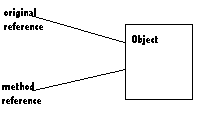Q: If Java uses the pass-by reference, why won't a swap function work?
A: Java does manipulate objects by reference, and all object variables are references. However, Java doesn't pass method arguments by reference; it passes them by value.
Take the badSwap() method for example:
public void badSwap(int var1, int var2) { int temp = var1; var1 = var2; var2 = temp; }
When badSwap() returns, the variables passed as arguments will still hold their original values. The method will also fail if we change the arguments type from int to Object, since Java passes object references by value as well. Now, here is where it gets tricky:
public void tricky(Point arg1, Point arg2) { arg1.x = 100; arg1.y = 100; Point temp = arg1; arg1 = arg2; arg2 = temp; } public static void main(String [] args) { Point pnt1 = new Point(0,0); Point pnt2 = new Point(0,0); System.out.println("X: " + pnt1.x + " Y: " +pnt1.y); System.out.println("X: " + pnt2.x + " Y: " +pnt2.y); System.out.println(" "); tricky(pnt1,pnt2); System.out.println("X: " + pnt1.x + " Y:" + pnt1.y); System.out.println("X: " + pnt2.x + " Y: " +pnt2.y); }
If we execute this main() method, we see the following output:
X: 0 Y: 0 X: 0 Y: 0 X: 100 Y: 100 X: 0 Y: 0
The method successfully alters the value ofpnt1, even though it is passed by value; however, a swap of pnt1 and pnt2 fails! This is the major source of confusion. In the main()method, pnt1 and pnt2 are nothing more than object references. When you pass pnt1 and pnt2 to the tricky() method, Java passes the references by value just like any other parameter. This means the references passed to the method are actually copies of the original references. Figure 1 below shows two references pointing to the same object after Java passes an object to a method.
 Figure 1. After being passed to a method, an object will have at least two references
Figure 1. After being passed to a method, an object will have at least two references
Java copies and passes thereferenceby value, not the object. Thus, method manipulation will alter the objects, since the references point to the original objects. But since the references are copies, swaps will fail. As Figure 2 illustrates, the method references swap, but not the original references. Unfortunately, after a method call, you are left with only the unswapped original references. For a swap to succeed outside of the method call, we need to swap the original references, not the copies.
 Figure 2. Only the method references are swapped, not the original ones
Figure 2. Only the method references are swapped, not the original ones
O'Reilly's Java in a Nutshell by David Flanagan (seeResources) puts it best: "Java manipulates objects 'by reference,' but it passes object references to methods 'by value.'"





 本文探讨了Java中参数传递的方式,并通过实例说明了为何在Java中无法通过方法调用成功交换两个对象引用的原因。文章指出Java对于基本类型采用传值方式,而对于对象则传递的是引用的拷贝。
本文探讨了Java中参数传递的方式,并通过实例说明了为何在Java中无法通过方法调用成功交换两个对象引用的原因。文章指出Java对于基本类型采用传值方式,而对于对象则传递的是引用的拷贝。


















 123
123

 被折叠的 条评论
为什么被折叠?
被折叠的 条评论
为什么被折叠?








